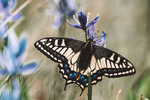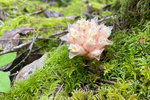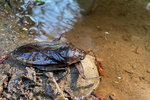


Ever seen a groundcone? This summer two people have sent me snapshots of this strange plant. A groundcone looks about how it sounds, like a pine cone growing out of the ground, translucent yellow and fleshy when young and purple-brown when mature.
It needs no green. It is a parasite. For roots it has long structures called haustoria that penetrate the cells of the roots of another plant — in our case, salal — and siphon the water and nutrients it needs to grow.
It is summer. Our forests are nearly as crispy-dry as our fields, yet they contain hidden glades, seeps, ravines; oases for those who cannot stand the heat. I keep finding myself covered by spiderwebs and boxed in by thorns in places pervaded with mystery. And in sun-dappled openings between sword ferns, strange beasts lurk: Plants. Parasitic plants.
A mushroom foraging friend has been my go-to source for where to track them. After all, groundcones look a lot like another secretive cone-mimic: morel mushrooms. Today he shows me my first gnome-plant. It is a dense bouquet of pink-blushed flowers bursting from underground, naked, leafless, looking like it would scald in direct sun.
My friend tells me he often sees another parasitic plant around here, Indian pipe, which lifts a single colorless flower on a colorless stalk and bends that flower back downward as if the ground will better appreciate it than the sky. Though we cannot find it today, Indian pipe is less rare than gnome-plant.
Both were once thought to be saprophytes, feeding like many mushrooms on decaying plant matter. It is now known that they are true parasites that steal from living beings. In their cases, along with about 400 other plant species worldwide, they parasitize not plants but mushrooms by tapping into underground networks of fungal hyphae. Which is a fantastic oddity to me. I usually think of mushrooms as being the ones to sap the strength of plants, as in the case of laminated root rot in Douglas fir, but these plants have flipped the script. They have jettisoned leaves and chlorophyll to take nutrients from specific types of mushrooms, which in turn are often growing in relationship with tree roots. There are many tricks up the sleeves of the plant kingdom.
Our local bestiary of parasitic plants also contains the entangling tendrils of salt-marsh dodder, explosions of mistletoe growth high in hemlocks, and orchids like the spotted coralroot. We live in a cradle of strange forms. So much growth and life burst from our forests that plants and mushrooms alike have found many ways of seeking and stealing the things they need.
The other day my neighbors were netting tiny bass from a pool below a beaver dam and releasing them into the lake above. In a nearby ditch they found a large bug they thought was a beetle.
Brown and leaf-shaped with its front legs modified into raptorial arms, it seized on the sticks they offered, striking hard enough to send a jolt through their hands. It was in fact a bug, not a beetle, a native species called the giant water bug (Lethocerus americanus).
“A favorite with biologists and naturalists,” according to a 1924 paper, giant water bugs are known for “extreme voraciousness” and an ability to subdue prey larger than themselves. Ours measured 2-1/4 inches, not including the legs. True bugs (order Hemiptera, which also includes aphids, cicadas, shield bugs and many others) have mouthparts modified into sharp beaks designed to pierce and suck. Most feed on plant sap. Others, like the giant water bug, are predators.
The giant water bug’s bite — I have yet to experience it — is said to be far worse than a wasp’s sting. It feeds by hammering its beak through a prey’s carapace and injecting a venom designed to liquify innards, so that it can suck out the resulting juice.
That 1924 paper, coming from an age of freeform experimentation on wild animals, says that one captive giant water bug “fed greedily upon beefsteak, grasshoppers, tadpoles, young frogs, young fish, flies, and other things.” Another paper tells the story of campers in Montana who went to a creek to catch brook trout for breakfast. They noticed a giant water bug floating on the surface, motionless except for one arm, which it waved at a 10-inch trout. When the trout grabbed the leg, the giant water bug reared up and sank its beak into the top of the trout’s head. The bug waited while the trout thrashed and died.
Even back then giant water bugs were also known as electric-light bugs. They move from place to place at night using celestial navigation, and electric lights can trick them into spiral flights that exhaust and sometimes kill them. The Lights Out movement in cities around America, which aims to prevent the disorientation of migrating birds, is good for insects as well.
We released the giant water bug into the pool below the beaver dam and watched it propel itself to the bottom, where it nestled among leaves. Soon it could hardly be seen. Makes you think twice about stepping in a lake — though bites are very rare. They do have another name that is not for the faint of heart: toe-biters.
Now I feel obligated to end this column on a brighter note. How about butterflies?
How about tiger swallowtails, our biggest and brightest butterflies? Did you know that we have not one but three species of the yellow-and-black drifters?
There is the western tiger swallowtail, with bright yellow wings outlined and zigzagged with black. Then the pale swallowtail, which looks like a washed-out version of the western. Then the anise swallowtail, which has almost as much black as yellow in its wings, with the black concentrated toward the leading edges.
Next time you see one, try to identify the species. It’s an addicting game. As you know if you’ve tried to snap a picture of one, they’re adept at looking like they’re about to land and then drifting on, just out of reach, pulling you across hill and field.
UNDERWRITTEN BY THE FUND FOR NONPROFIT NEWS (NEWSMATCH) AT THE MIAMI FOUNDATION, THE ANGEL GUILD, ADVERTISERS, DONORS AND PEOPLE WHO SUPPORT INDEPENDENT, NONPROFIT LOCAL NEWS